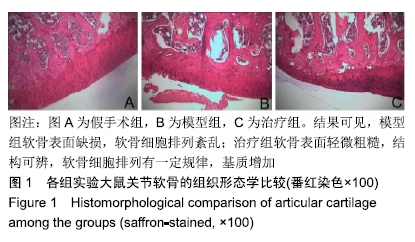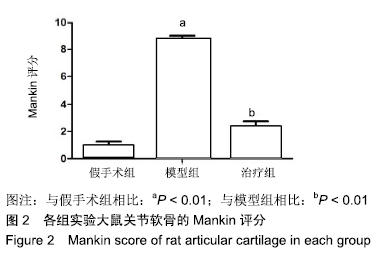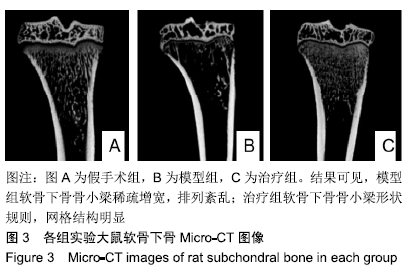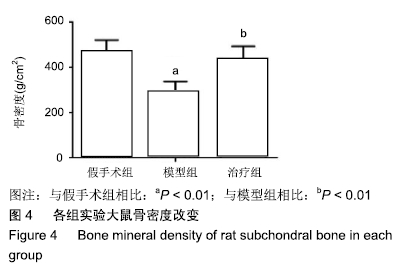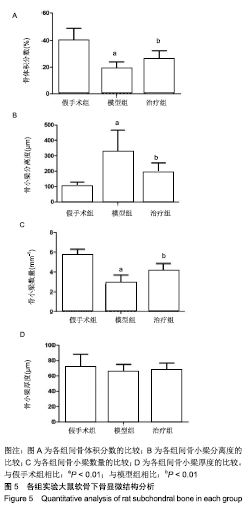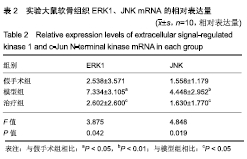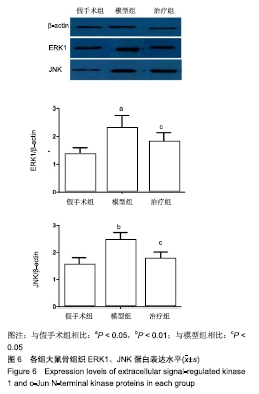中国组织工程研究 ›› 2020, Vol. 24 ›› Issue (2): 181-186.doi: 10.3969/j.issn.2095-4344.1911
• 骨组织构建 bone tissue construction • 上一篇 下一篇
伊班膦酸钠干预骨关节炎模型大鼠丝裂原活化蛋白激酶信号通路的变化
刘 静1,2,孙智路3,周 君1,2,廖 源1,2,孙光华1,2,伍 琦1,2,周桂娟1,2,钟培瑞1,2,成 果1,2,肖 豪1,2,李 兰1,2,廖 瑛1,2
- 南华大学附属第一医院,1康复医学科,2康复医学实验室,3急诊科,湖南省衡阳市 421001
Effect of ibandronate on mitogen-activated protein kinase signaling pathway in rat models of osteoarthritis
Liu Jing1, 2, Sun Zhilu3, Zhou Jun1, 2, Liao Yuan1, 2, Sun Guanghua1, 2, Wu Qi1, 2, Zhou Guijuan1, 2, Zhong Peirui1, 2, Cheng Guo1, 2, Xiao Hao1, 2, Li Lan1, 2, Liao Ying1, 2
- 1Department of Rehabilitation, 2Laboratory of Rehabilitation Medicine, 3Department of Emergency, the First Affiliated Hospital of University of South China, Hengyang 421001, Hunan Province, China
摘要:

文题释义:
丝裂原活化蛋白激酶(Mitogen-activated protein kinases,MAPKs)信号通路:是一组能被不同的细胞外刺激,如细胞因子、神经递质、激素、细胞应激及细胞黏附等激活的丝氨酸-苏氨酸蛋白激酶,是细胞表面传导到细胞核内部的重要传递者。
背景:丝裂原活化蛋白激酶信号通路参与成骨细胞与破骨细胞的分化,与软骨下骨重建过程密切相关,在骨关节炎的发生发展中起重要作用。双膦酸盐作为骨吸收抑制剂,主要用于骨质疏松的治疗。
目的:探讨伊班膦酸钠对大鼠骨关节炎的治疗效果,以及其对丝裂原活化蛋白激酶信号通路的影响。
方法:实验方案经南华大学附属第一医院动物实验伦理委员会批准。30只雌性SD大鼠随机分为假手术组、模型组、治疗组。模型组和治疗组行双侧去卵巢及前交叉韧带切断术,假手术组大鼠只切除卵巢周围与卵巢大小相仿的脂肪组织,切开双侧膝关节腔,但不切断前交叉韧带。术后1周,治疗组予以腹腔注射伊班膦酸钠10 μg/kg,模型组予以腹腔注射等量生理盐水,假手术组不作干预。12周以后,处死实验动物,进行关节软骨的组织形态学观察及Mankin评分,软骨下骨的Micro-CT扫描及骨组织显微结构定量分析,检测丝裂原活化蛋白激酶信号通路中细胞外信号调节蛋白激酶(ERK1)和c-Jun氨基酸末端激酶(JNK)的mRNA表达量及蛋白表达水平。
结果与结论:①模型组软骨结构明显破坏,Mankin评分较假手术组明显增高,而治疗组的Mankin评分较模型组显著降低(P < 0.01);②与假手术组比较,模型组中的骨密度、骨体积分数、骨小梁数量降低,骨小梁分离度显著增高(P < 0.01);与模型组相比,治疗组的骨密度、骨体积分数、骨小梁数量增加,骨小梁分离度明显下降(P < 0.01);③模型组中的ERK1、JNK mRNA表达和蛋白表达较假手术组明显增加(P < 0.05,P < 0.01);与模型组相比,治疗组中的ERK1、JNK mRNA表达和蛋白表达显著降低(P < 0.05);④结果说明,伊班膦酸钠可能通过抑制ERK1、JNK 丝裂原活化蛋白激酶信号通路的表达改善膝骨关节炎大鼠的软骨下骨的微结构,抑制软骨的退变。ORCID: 0000-0003-3433-364X(刘静)
中国组织工程研究杂志出版内容重点:组织构建;骨细胞;软骨细胞;细胞培养;成纤维细胞;血管内皮细胞;骨质疏松;组织工程
中图分类号:
